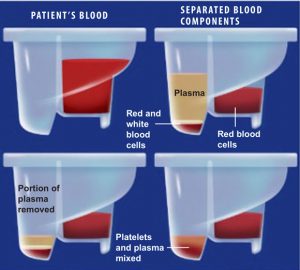Platelet rich plasma (PRP) therapy
is a revolutionary new treatment that relieves pain by promoting long lasting healing of musculoskeletal conditions. Used by many professional athletes including Hines Ward and Tiger Woods, PRP therapy is accepted in pain, orthopedic, and sports medicine practices in the U.S. and many countries.
What is PRP therapy used for?
This rapidly emerging technique is showing exciting potential with osteoarthritis of the knee, shoulder, hip and spine, rotator cuff tears, chronic plantar fasciitis, anterior cruciate ligament (ACL) injuries, pelvic pain and instability, back and neck injuries, tennis elbow, ankle sprains, tendonitis, and ligament sprains. JPRC Neuro-spine centre staff includes expert physicians in the region currently trained in PRP therapy. They can determine if this advanced, non-surgical treatment is right for you.
How does PRP therapy work?
The body’s first response to soft tissue injury is to deliver platelet cells. Packed with growth and healing factors, platelets initiate repair and attract the critical assistance of stem cells. PRP therapy’s natural healing process intensifies the body’s efforts by delivering a higher concentration of platelets. To create PRP therapy, a small sample of your blood is drawn (similar to a lab test sample) and placed in a centrifuge that spins the blood at high speeds, separating the platelets from the other components. The concentrated platelet rich plasma (PRP) is then injected into and around the point of injury, jump-starting and significantly strengthening the body’s natural healing signal. Because your own blood is used, there is no risk of a transmissible infection and a very low risk of allergic reaction.
What are the potential benefits?
Patients can see a significant improvement in symptoms. This may eliminate the need for more aggressive treatments such as long term medication or surgery, as well as a remarkable return of function.
How long does it take?
The procedure takes approximately one to two hours, including preparation and recovery time. PRP therapy is performed safely at the medical office or Surgery Center and relieves pain without the risks of surgery, general anesthesia, or hospital stays and without a prolonged recovery. In fact, most people return to their jobs or usual activities right after the procedure.
How often is this therapy done?
While responses to treatment vary, most people will require 1-3 sets of injections, usually performed three to five weeks apart. You may, however, gain considerable to complete relief after the first or second injection.
What are the expected results?
Because the goal of PRP therapy is to resolve pain through healing, it could prove to have lasting results. Initial improvement may be seen within a few weeks, gradually increasing as the healing progresses. Research studies and clinical practice have shown PRP therapy to be very effective at relieving pain and returning patients to their normal lives. Both ultrasound and MRI images have shown definitive tissue repair after PRP therapy, confirming the healing process. The need for surgery can also be greatly reduced by treating injured tissues before the damage progresses and the condition is irreversible.
Is PRP right for me?
If you have a tendon or ligament injury and traditional methods have not provided relief, then PRP therapy may be the solution. The procedure is less aggressive and less expensive than surgery. It will heal tissue with minimal or no scarring, and alleviates further degeneration of the tissues. There will be an initial evaluation with your doctor to see if PRP therapy is right for you.

